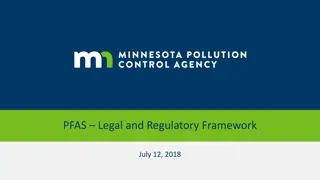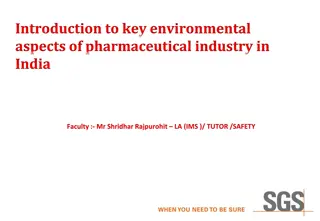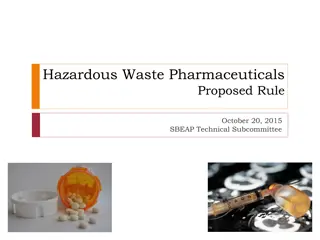Making RCRA Hazardous Waste Regulations Work for Site Cleanup
Explore how to effectively utilize RCRA hazardous waste regulations and policies to facilitate site cleanup and re-use, addressing misconceptions and highlighting key strategies. Understand the importance of planning ahead and selecting appropriate cleanup remedies, waste determination, and regulatory tools to achieve successful cleanup outcomes. Key considerations such as site-specific risks, future land use, and community acceptance are emphasized for a comprehensive approach to environmental remediation.
Download Presentation

Please find below an Image/Link to download the presentation.
The content on the website is provided AS IS for your information and personal use only. It may not be sold, licensed, or shared on other websites without obtaining consent from the author.If you encounter any issues during the download, it is possible that the publisher has removed the file from their server.
You are allowed to download the files provided on this website for personal or commercial use, subject to the condition that they are used lawfully. All files are the property of their respective owners.
The content on the website is provided AS IS for your information and personal use only. It may not be sold, licensed, or shared on other websites without obtaining consent from the author.
E N D
Presentation Transcript
DISCLAIMER Notice: This presentation has been provided as part of a U.S. Environmental Protection Agency webinar. The document does not constitute EPA policy. Mention of trade names or commercial products does not constitute endorsement or recommendation for use. Links to non-EPA web sites do not imply any official EPA endorsement of or a responsibility for the opinions, ideas, data, or products presented at those locations or guarantee the validity of the information provided. Links to non-EPA servers are provided solely as a pointer to information that might be useful to EPA staff and the public.
Think before you dig! How to make RCRA hazardous waste regulations & policies work for you in cleaning up a site. By: Cheryl Nelson USEPA Region 9, San Francisco
Why is this topic important? There is a large universe of contaminated sites waiting clean up EPA wants to encourage clean up and re-use of contaminated sites There is a common misperception that RCRA regulations prevent cost-effective clean up There are many RCRA policies/regulations that remove barriers to aggressive/effective clean up These policies/regulations mostly only work if you invoke/plan for them BEFORE you start digging.
Bottom Line: Think it through before you dig!
The Successful Cleanup Process Choose your cleanup remedy. (This is generally based upon the site-specific risk and future land use but also includes other factors (e.g. post-construction controls, community acceptance, cost, etc.) Make a waste determination for all waste streams; determine which are hazardous Determine if LDR treatment standards apply (attach) to each hazardous waste stream, and where in the cleanup process (i.e., where is the point of generation?) If LDRs attach, choose which treatment standards apply (e.g. UHCs; alternative soil standards, etc.) Work backwards from the chosen remedy to pick the most flexible RCRA regulatory unit/policy/tool that will achieve both the risk numbers (cleanup goals) and, where applicable, LDR treatment standards.
7 Keys to Successful clean up 1. Identify the optimum site remedy based upon future land use and mitigating site risk. 2. Prepare an accurate waste identification under RCRA for all potentially contaminated materials at the site. (This can be done by developing and using a conceptual site model to guide site characterization and identification of wastes). 3. Work backwards from the remedy to find the best RCRA flexible policy/pathway to get there. 4. Use the Contained-in-Policy and the Area of Contamination Policy to help avoidtriggering the LDR s unnecessarily.
7 Keys to Successful clean up (Continued) 5. Use the alternative LDR treatment standards for contaminated soil (40 CFR 268.49), and the treatment standards for hazardous debris (40 CFR 268.45) to significantly reduce the need to treat these materials when LDR s can t be avoided. Use a site-specific variance from a treatment standard (40 CFR 268.44 (h)) if it is unachievable to meet the LDR s or if it is inappropriate to do so. 6. Use the generator treatment or other RCRA recycling or treatment exclusions to avoid having to get a RCRA permit. 7. Document all of your decisions/policies in your public documents and statement of basis.
First Key to Success/Resources Identify the optimum site remedy based upon future land use and mitigating site risk. Presumptive Remedies http://www.epa.gov/superfund/policy/remedy/presump/pol.htm Handbook of GW Protection and cleanup Policies for RCRA Corrective Action http://www.epa.gov/wastes/hazard/correctiveaction/resources/gui dance/gw/gwhandbk/index.htm RCRA Subpart S Corrective Action Guidance http://www.gpo.gov/fdsys/pkg/FR-1996-05-01/pdf/96-9707.pdf
Second Key to Success/Resources Prepare an accurate waste identification under RCRA for all potentially contaminated materials at the site. (This can be done by developing and using a conceptual site model to guide site characterization and identification of wastes). Definition of Solid Waste webpage (includes DSW tool and links to key regulations) http://www.epa.gov/epawaste/hazard/dsw/index.htm Contained in Policy http://www.epa.gov/epawaste/inforesources/online/index.htm RCRA Online (EPA database of key policies/letters) http://www.epa.gov/epawaste/inforesources/online/index.htm Site Conceptual Model http://www.epa.gov/osw/hazard/correctiveaction/pdfs/workshop/c sm_slides.pdf
Tips for identifying contaminated media Environmental media (soil, groundwater, sediment) are not solid wastes under RCRA and hence cannot be hazardous wastes if contaminated. However, under EPA s Contained in Policy, contaminated environmental media can become subject to regulation under RCRA if they contain hazardous waste such as when: a) they exhibit a characteristic of hazardous waste or b) when they are contaminated with concentrations of hazardous constituents from listed hazardous wastes that are above health- based levels
Tips for determining Listed Hazardous Wastes Understand the relationship between when a chemical was spilled, versus the effective date of when it was listed as a hazardous waste (e.g. when it was/becomes subject to RCRA). Listed wastes created, spilled, or disposed prior to their respective listing date haven t been generated yet and therefore aren t hazardous wastes when subsequently disturbed, excavated, or managed then they are generated and then are hazardous wastes Listed wastes created, spilled, or disposed after their respective listing date have already been generated and are already listed hazardous wastes.
Point of generation for media contaminated with listed hazardous waste If LDRs And If LDRs And If Then you Applied to the listed waste when it contaminated the soil*. Apply to the listed waste now ............ Must comply with LDRs. ............................. The soil is determined to contain the listed waste when the soil is first generated. Didn t apply to the listed waste when it contaminated the soil*. Apply to the listed waste now ............ Must comply with LDRs. The soil is determined not to contain the listed waste when the soil is first generated. Didn t apply to the listed waste when it contaminated the soil*. Apply to the listed waste now ............ Needn t comply with LDRs. Didn t apply to the listed waste when it contaminated the soil*. Don t apply to the listed waste now Needn t comply with LDRs. ............................. * For dates of LDR applicability, see 40 CFR Part 268 Appendix VII. To determine the date any given listed hazardous waste contaminated any given volume of soil, use the last date any given listed hazardous waste was placed into any given land disposal unit or, in the case of an accidental spill, the date of the spill.
Third Key to Success/Resources Work backwards from the remedy to find the best RCRA flexible policy/pathway to get there. History of RCRA Corrective action http://www.epa.gov/epawaste/hazard/correctiveaction/re sources/guidance/gen_ca/cafs1.pdf Management of Remediation Waste Under RCRA http://yosemite.epa.gov/osw/rcra.nsf/0c994248c239947e8525 6d090071175f/D9E61A0505DB4B6885256817006E32B8/$file/142 91.pdf
Fourth Key to Success/Resources Use the Contained-in-Policy and the Area of Contamination Policy to help avoidgenerating waste and/or triggeringthe LDR s unnecessarily. Contained in policy http://yosemite.epa.gov/osw/rcra.nsf/0c994248c239947e85256d0 90071175f/1709125b14c9f0548525670f006bf311!OpenDocument Use of the Area of Contamination (AOC) Concept During RCRA Cleanups http://yosemite.epa.gov/osw/rcra.nsf/0c994248c239947e85256d0 90071175f/E6CAC7C42B27CE048525670F006BF350/$file/11954.pdf Compilation of guidance on remediation waste policies http://www.epa.gov/epawaste/hazard/correctiveaction /resources/guidance/index.htm
Fifth Key to Success/Resources Use the alternative LDR treatment standards for contaminated soil (40 CFR 268.49), and the treatment standards for hazardous debris (40 CFR 268.45) to significantly reduce the need to treat these materials when LDR s can t be avoided. Use a site-specific variance from a treatment standard (40 CFR 268.44 (h)) if it is unachievable to meet the LDR s or if it is inappropriate to do so. 40 CFR 268.49, 40 CFR 268.45, 40 CFR 268.44 http://www.gpo.gov/fdsys/pkg/CFR-2014-title40-vol27/pdf/CFR-2014- title40-vol27-part268.pdf LDR Phase IV Preamble on contaminated soil (63FR 28602) http://www.gpo.gov/fdsys/pkg/FR-1998-05-26/pdf/98-12575.pdf Superfund Guidance on LDR variances: http://www.epa.gov/superfund/policy/remedy/sfremedy/arars/rcra.h tm
Sixth Key to Success/Resources Use the generator treatment or other RCRA recycling or treatment exclusions to avoid having to get a RCRA permit. Generator Treatment http://yosemite.epa.gov/osw/rcra.n sf/0c994248c239947e85256d0900711 75f/57ac820a47a8bc4e85256d160074 8c43!OpenDocument Management of Remediation Waste Under RCRA http://yosemite.epa.gov/osw/rcra.nsf/0c 994248c239947e85256d090071175f/D9E61 A0505DB4B6885256817006E32B8/$file/142 91.pdf
Seventh Key to Success/Resources Document all of your decisions/policies in your public documents and statement of basis. Statement of Basis http://www.epa.gov/epawaste/hazard/c orrectiveaction/sbs2/index.htm Risk-based clean closure guidance http://www.epa.gov/epawaste/hazard/c orrectiveaction/resources/guidance/risk/ cclosfnl.pdf
Other Resources Corrective Action Main Webpage: http://www.epa.gov/epawaste/hazard/correctiveaction/r esources/guidance/index.htm RCRA Information Network (RIN) Call A national monthly call (first Wednesday of the month at 2 pm EDT) of EPA and State Staff to discuss a wide range of issues related to regulatory interpretation of the RCRA program. Hosted by EPA HQ office: ORCR (Jim O Leary) Webpage on use of RCRA ARARS at Superfund sites: http://www.epa.gov/superfund/policy/remedy/sfremedy/ arars/rcra.htm RCRA Corrective Action Enforcement Authorities http://www2.epa.gov/enforcement/rcra-corrective- action-enforcement-authorities
Case Study/Example You are the lead regulator for a site that formerly operated a vapor degreaser from 1980 to 1992 that resulted in Tetrachloroethylene (PCE) contamination of soil beneath the building that held the degreaser. Concentrations of PCE in soil range from ND up to 450 ppm. The owner s proposed remedy is to demolish the degreaser/building, and excavate contaminated soil above the cleanup level (5 ppm) and dispose all to a local Subtitle D landfill. Is this acceptable? 1. What are the potential waste streams for this site? Are any hazardous? 2. Are any of the wastes subject to LDRs? 3. What do you think of the owner s proposed remedy? What additional requirements, if any, would you impose? 4. What other options does the owner have to avoid triggering costly RCRA regulations?
Case Study Solution The potential waste streams are: 1. Contaminated soil with PCE a listed waste F001 (spilled after effective date of regulation see 40 CFR 268 Appx. VII); need additional data (TCLP test) to determine if also D039 Degreaser/building debris contaminated with PCE with a listed waste F001; also potentially D039 Media and Debris contaminated with a listed waste are subject to the contained-in-policy. Refer to table VII in 40 CFR 261 for the list of constituents for which each listed waste is listed for. For F001 constituents include: Tetrachloroethylene, methylene, chloride, trichloroethylene, 1,1,1-trichloroethane, carbon tetrachloride, chlorinated fluorocarbons To make a contained in determination, would need additional data such as soil concentrations of the above constituents. Also need sampling/analytical data from the degreaser and building debris for all these constituents. To make the contained in decision, need to compare the concentrations of chemical constituents against health-based risk concentrations.
Case Study Solution 2. Do LDR s apply? The site operated from 1980 to 1992 and therefore chemicals were spilled both prior to and after the effective date of listing (1986 according to Table 1 in Appendix VII in 40 CFR 268). The wastes therefore were subject to LDRs when spilled after 1986. LDRs therefore, attached when the spill occurred and now must be satisfied. For the soil: can either meet the numeric standards for F001 in 40 CFR 268.40 or the alternative soil treatment standard of 90% reduction or 10X UTS in 40 CFR 268.49. For the debris: can either meet the numeric standards for F001 in 40 CFR 268.40 or the alternative debris standards in 40 CFR 268.45
Case Study Solution 3. Is the proposed remedy acceptable? The contaminated soil and potentially contaminated debris are both listed hazardous wastes and subject to LDRs. Therefore, without treatment and a contained in decision, the soil and debris cannot be disposed in a local (subtitle D) landfill, but must be managed and disposed as listed hazardous waste. Additional requirements that should be imposed are: Owner is subject to RCRA generator regulations (must have an ID #, must manage/store the waste as hazardous (e.g. drummed, labeled, less than 90 day accumulation), waste must be manifested to a permitted TSDF.
Case Study Solution Other Options: 4. Segregate soil during excavation to minimize amount that must be disposed as hazardous. Treat soil to meet LDRs, and if this is below risk-based levels then contain out/dispose to Subtitle D landfill. Consolidate soil inside Area of Contamination and use generator treatment in tanks/containers to meet LDRs. And/or petition for LDR variance if the LDR s are inhibiting aggressive remediation or are not achievable. Treat debris using destruction/removal standard; then contain out/dispose to Subtitle D landfill. Or, metal can be decontaminated and reclaimed as scrap and/or reused. Consolidate soil in Area of Contamination and treat in-situ to meet LDRs and then cap. If capping not protective or if area of contamination is not contiguous then build a CAMU. CAMU would require a RCRA permit, RAP, or Order.
Lesson Learned! Think it through before you dig In some cases digging up contaminated soil generates the soil to become a RCRA hazardous waste! Once generated you can t un-generate it. If the soil/waste is subject to the Land Disposal Restriction Standards then you have also triggered the need to treat the soil/waste. Some treatment standards require incineration (!) adding exponentially to the cost of the clean up. Even without treatment the cost of hauling and disposing the soil/waste will significantly add to your site clean up.
Lesson Learned! (Continued) Think it through before you dig Once generated a 90-day clock starts ticking that requires you to remove the soil/waste from the site and treat/dispose it at a RCRA HW facility. If you run out the 90-day clock then you trigger the need for a RCRA permit for storage at the site. This will exponentially add to the time and cost for the clean up. You can often avoid ALL of these triggers if you think it through and plan for it before you dig it up!
Important Take Home Messages Decide what the right thing to do is for the clean up given the future use of the property Work backwards from this outcome to ensure that all aspects of the clean up are planned before proceeding Identify if you have any hazardous waste or hazardous contaminated media or debris (where and how much) Use the RCRA flexible policies and regs to avoid triggering unnecessary RCRA regulation/disposal and reduce cost THINK BEFORE YOU DIG!!























